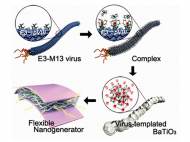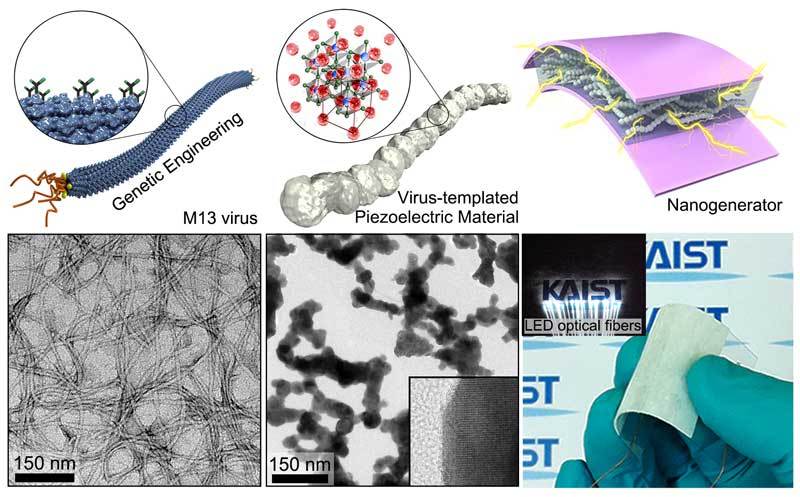Virus-templated fabrication of piezoelectric nanogenerators
 A group of researchers at the Korea Advanced Institute of Science and Technology (KAIST) has synthesized a nanogenerator – a flexible piezoelectric energy harvesting device based on biological templates. The biotemplated nanogenerator is low cost and it can be self-powered by simple finger movements that could be used to power small commercial LCD screens and LED bulbs.
A group of researchers at the Korea Advanced Institute of Science and Technology (KAIST) has synthesized a nanogenerator – a flexible piezoelectric energy harvesting device based on biological templates. The biotemplated nanogenerator is low cost and it can be self-powered by simple finger movements that could be used to power small commercial LCD screens and LED bulbs.
Biological systems have capabilities to spontaneously synthesize unique materials with sophisticated architectures such as shells, sea sponges, and bone minerals. Unlike natural syntheses, most of artificial syntheses are performed under toxic, costly and extreme environments. In order to produce materials in a cost-effective and environmentally-friendly way, researchers groups around the world look for the solution in nature and try to mimic biological processes.
KAIST research team, led by Professor Keon Jae Lee and Professor Yoon Sung Nam from the Department of Materials Science and Engineering, has modified a M13 viral gene that can synthesize barium titanate (BaTiO3 or BTO) – a highly piezoelectric inorganic material. This virus is harmless to humans and it’s widely present in nature. It has been successfully utilized as a genetically programmable toolkit for the synthesis of BTO nanostructures.
Using the biotemplated piezoelectric material, researchers have fabricated high-output and flexible nanogenerator that converts mechanical energy of tiny movements into electrical energy. According to KAIST Flexible and Nanobio Device Lab researchers, periodical mechanical motions are enough to help achieve output performance of up to 300 nanoampere and six volts.
“This is the first time to introduce a biotemplated inorganic piezoelectric material to a self-powered energy harvesting system, which can be realized through eco-friendly and efficient material syntheses”, said Lee.
The nanogenerator fabricated by virus-templated BTO nanostructure is highly stable and suitable for energy harvesting. With enhanced performance, the nanogenerator is an attractive candidate for the next generation energy harvesting technology. Furthermore, biosynthetic method for nanostructure creation could open a new era of bioinspired self-assembly technologies ranging from thermoelectrics to biofuel cells.
For more information, you can read the article published in the journal ACS Nano: “Virus-directed design of a flexible BaTiO3 nanogenerator” [8.4MB PDF].










Leave your response!